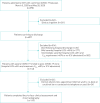Chest radiography is a poor predictor of respiratory symptoms and functional impairment in survivors of severe COVID-19 pneumonia
- PMID: 33575312
- PMCID: PMC7585700
- DOI: 10.1183/23120541.00655-2020
Chest radiography is a poor predictor of respiratory symptoms and functional impairment in survivors of severe COVID-19 pneumonia
Abstract
Background: A standardised approach to assessing COVID-19 survivors has not been established, largely due to the paucity of data on medium- and long-term sequelae. Interval chest radiography is recommended following community-acquired pneumonia; however, its utility in monitoring recovery from COVID-19 pneumonia remains unclear.
Methods: This was a prospective single-centre observational cohort study. Patients hospitalised with severe COVID-19 pneumonia (admission duration ≥48 h and oxygen requirement ≥40% or critical care admission) underwent face-to-face assessment at 4-6 weeks post-discharge. The primary outcome was radiological resolution of COVID-19 pneumonitis (Radiographic Assessment of Lung Oedema score <5). Secondary outcomes included clinical outcomes, symptom questionnaires, mental health screening (Trauma Screening Questionnaire, seven-item Generalised Anxiety Disorder assessment and nine-item Patient Health Questionnaire) and physiological testing (4-m gait speed (4MGS) and 1-min Sit-to-Stand (STS) tests).
Results: 119 patients were assessed between June 3, 2020 and July 2, 2020 at median (interquartile range (IQR)) 61 (51-67) days post-discharge: mean±sd age 58.7±14.4 years, median (IQR) body mass index 30.0 (25.9-35.2) kg·m-2, 62% male and 70% ethnic minority. Despite radiographic resolution of pulmonary infiltrates in 87%, modified Medical Research Council Dyspnoea (breathlessness) scale grades were above pre-COVID-19 baseline in 44%, and patients reported persistent fatigue (68%), sleep disturbance (57%) and breathlessness (32%). Screening thresholds were breached for post-traumatic stress disorder (25%), anxiety (22%) and depression (18%). 4MGS was slow (<0.8 m·s-1) in 38% and 35% desaturated by ≥4% during the STS test. Of 56 thoracic computed tomography scans performed, 75% demonstrated COVID-19-related interstitial and/or airways disease.
Conclusions: Persistent symptoms, adverse mental health outcomes and physiological impairment are common 2 months after severe COVID-19 pneumonia. Follow-up chest radiography is a poor marker of recovery; therefore, holistic face-to-face assessment is recommended to facilitate early recognition and management of post-COVID-19 sequelae.
Copyright ©ERS 2021.
Conflict of interest statement
Conflict of interest: R.F. D'Cruz has nothing to disclose. Conflict of interest: M.D. Waller has nothing to disclose. Conflict of interest: F. Perrin has nothing to disclose. Conflict of interest: J. Periselneris reports lecture fees from Gilead outside the submitted work. Conflict of interest: S. Norton has nothing to disclose. Conflict of interest: L-J. Smith has nothing to disclose. Conflict of interest: T. Patrick has nothing to disclose. Conflict of interest: D. Walder has nothing to disclose. Conflict of interest: A. Heitmann has nothing to disclose. Conflict of interest: K. Lee has nothing to disclose. Conflict of interest: R. Madula has nothing to disclose. Conflict of interest: W. McNulty has nothing to disclose. Conflict of interest: P. Macedo has nothing to disclose. Conflict of interest: R. Lyall has nothing to disclose. Conflict of interest: G. Warwick has nothing to disclose. Conflict of interest: J.B. Galloway has nothing to disclose. Conflict of interest: S.S. Birring has nothing to disclose. Conflict of interest: A. Patel has nothing to disclose. Conflict of interest: I. Patel has nothing to disclose. Conflict of interest: C.J. Jolley has nothing to disclose.
Figures




References
-
- World Health Organization Timeline of WHO's response to COVID-19 2020. www.who.int/news-room/detail/29-06-2020-covidtimeline Date last accessed: July 10, 2020.
Grants and funding
LinkOut - more resources
Full Text Sources
